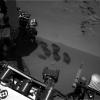news
Why the New Mars Findings are Only the Beginning
Primary tabs
On Monday, scientists controlling Curiosity provided an update on Mars. The rover has scooped up its first Martian soil sample, which has been examined by the Sample Analysis at Mars instrument (SAM). The soil contains hints of "organic" chemicals essential for life, but the scientists aren’t yet sure if the chemicals are native to Martian soil, from a meteorite or if they’re simply contamination from Curiosity's instruments made here on Earth. Future analysis will determine the origin.
School of Earth and Atmospheric Sciences Assistant Professor James Wray is on Curiosity's science team. He’s one of the first researchers to see the data and has pouring over the results for weeks. Wray was at Monday’s announcement in San Francisco.
“As a member of the SAM instrument science team, I could not be more excited about our first soil data from Mars. Since my career began at the beginning of grad school, I've mostly looked for evidence of water on Mars. The very first thing that jumped out of these data was a large release of water from the heated soils, implying that these "dry" sands are actually several percent water by weight. I (and many others) have pushed our Mars orbiter data to its limits in order to pull out weak, isolated signatures of carbonates or of salts of sulfur or chlorine that might have formed in ancient water. And now here we've immediately found evidence for all three in our very first sample, albeit at low concentrations. We can learn more than we ever could from orbit about how these compounds came to be, from clues like the temperature at which they break down in SAM's ovens or their proportions of different isotopes. The latter has already shown us that the water in this soil may be actively exchanging with the modern atmosphere.
“Finally, SAM can detect organic molecules, and we have indeed detected them, in the form of simple hydrocarbon molecules that have reacted with chlorine. The chlorine is almost certainly from the Martian soil, but we can't yet say whether all the hydrocarbons were chemical stowaways from Earth (we know we brought some along in SAM), or whether any were on Mars before we got there. But we do have the tools to resolve this question during the mission.
“Curiosity's landing site in Gale crater was chosen very carefully, but all of these early SAM results come from the most boring sample we could find there, a sand drift no different from what we could have accessed virtually anywhere else on Mars. We sampled it now to provide a "baseline" measurement to compare to the more intriguing, ancient sedimentary rocks of nearby Mount Sharp. So we have not even begun to do the science that we really came here for, but the early returns imply that all the science we wanted to do with SAM will be possible over the years ahead. By the end of the mission we will indeed have to rewrite the history books on Mars exploration; for now we're still working on the prologue, but it's a book you won't want to put down.”
Groups
Status
- Workflow Status:Published
- Created By:Jason Maderer
- Created:12/04/2012
- Modified By:Fletcher Moore
- Modified:10/07/2016
Categories
Keywords


